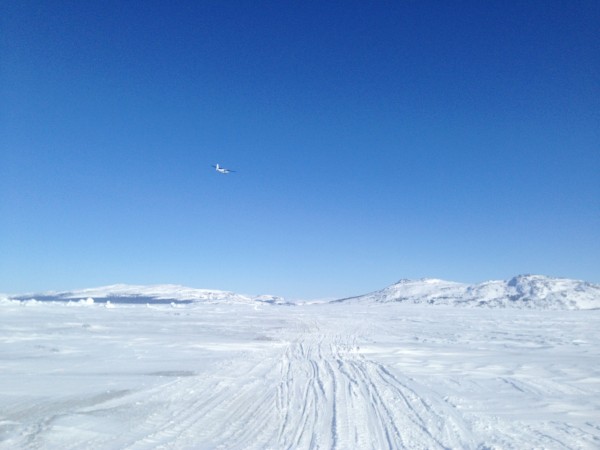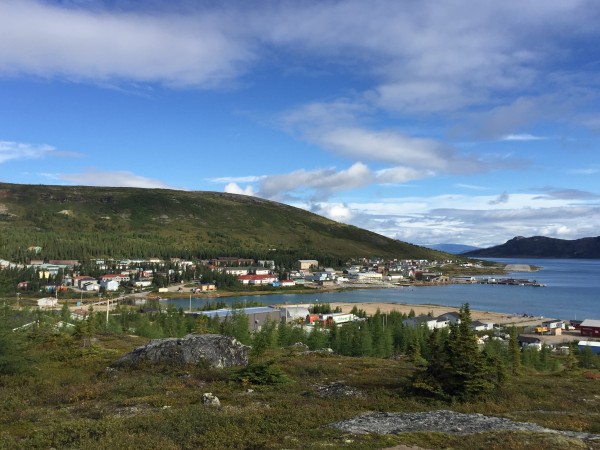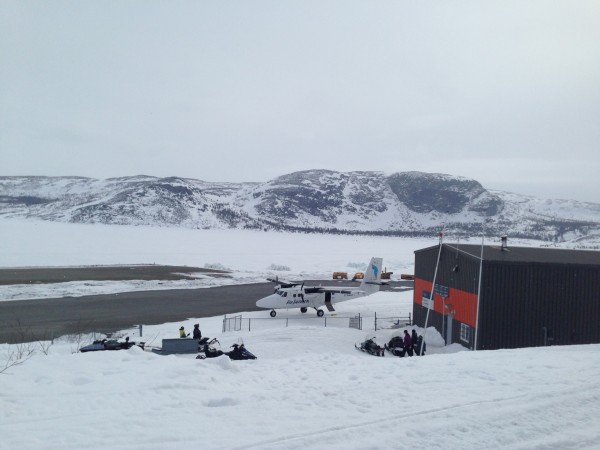Travelling in the winter can be a pain, it’s also just part of being Canadian. While we complain about winter driving and delayed flights, in most of Canada, year round travel and freedom of movement are givens. If Pearson or Trudeau Airports close because of weather it’s national news.
In northern Canada, the reality can be quite different. In Nunatsiavut, a self-governed area extending across northern Labrador, all travel is by plane. There are no roads connecting communities and, once the ocean freezes, no boats. From November 15th to July 15th, the only way in and out of Nunatsiavut is on 19 passenger Twin Otters. The planes are the local buses, mail delivery, couriers, ambulances and, in the winter, the only sources of fresh produce.
Twin Otters are hardy planes; they can fly in weather and land on rough ground. But there are limits. Many of the communities in Nunatsiavut have rudimentary runways. In Nain, the administrative capital, the runway is 2,000 feet of gravel, not enough for a big plane or bad weather. The runways also lack the signalling technology that guides planes during landing in southern Canada. In Nunatsiavut, pilots must be able to see the runway. In Nain, the local mountain serves as a benchmark: if you can’t see the top of Mount Sophie, no one will be landing or leaving. Without runway lights, the landing window is limited to the short winter day.

From a combination of challenging weather and limited technology, days-long stretches without flights are common. About once a year these stretches extend to a week or more. This means no mail, no fresh food and no travel. The winter of 2014 saw eighteen days without travel. This year has been sunny, but there was no service between Christmas and New Years because of high winds.
For the people of Nunatsiavut, dealing with plane-free periods is part of life, but it affects everything from food shopping to how babies are born. I spoke with Sophie Tremblay-Morissette, who has lived in Nain since 2014. Every summer Tremblay-Morissette takes three days to travel south and buy provisions for the winter. This involves stuffing a truck with non-perishable food, driving to the end of the road system and putting it on the summer ferry, a trip that can cost thousands of dollars.
Nunatsiavut has basic medical services but parents are strongly encouraged to fly south to have babies. Any serious medical incident requires an airplane ambulance, which are subject to all the same weather challenges as everyday passenger planes. Given the danger of trying to land in inclement weather, medical crew are not told who they are picking up or why. If it’s too dangerous to fly, the ambulances don’t – without knowing who got left behind or how serious their condition was. Most women travel to Goose Bay – a military town with a hospital – a month before their due dates.

All travel plans in Nunatsiavut are weather dependent. There is no good season to fly; winter is the worst, but in summer fog presents its own challenge. People miss weddings, professional conferences and vacations. Tourists get stuck in Goose Bay, never making in into the beautiful Torngat Mountains at the northern tip of Nunatsiavut. People get stuck at home and away from home. Having friends to crash with in Goose Bay can be a big improvement over car camping, a common option during long weather delays. When I was in Nunatsiavut last summer, we were fogged out for 24 hours, a pretty short delay, considering.
Tremblay-Morrisette noted, that after a few days fogged in, she is reminded of the isolated nature of her community: “It is a bit scary, but you get used to it.”
Shoshanna Saxe in an Engineer from Toronto. She is a 2015 Action Canada Fellow. Say hello on twitter @shoshannasaxe.


2 comments
Just have to say that I lived in Nunatsiavut for 35 years and never did a shopping expedition like the one described although I did have a meat order a couple of times. I relied solely on whatever the local stores had and the bounty of the land. It is mostly people with Government jobs that can afford to bring in a large supply of food/goods. However the price of food airlifted in is pretty outrageous and so residents have to do whatever it takes!
Great info as always.